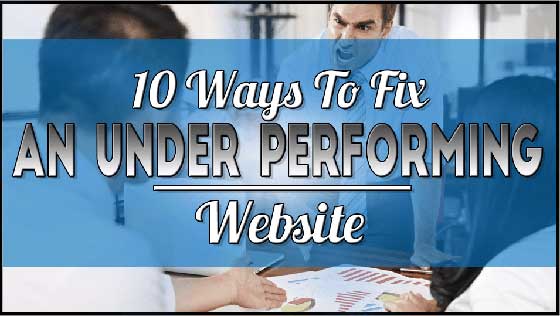Having a website is only one part of the digital marketing equation. The other part is making sure that it delivers what you need in terms of brand awareness, qualified leads, industry credibility.. the list goes on. Few sites have got it made to the point that they are delivering on all fronts, however. Here are some of the most common ways websites under perform, and how you can resolve them.
Table of Contents
ToggleYour Design Sucks
Like it or not, people are visual creatures and although there are multiple other aspects of website design to take into account, the look and feel remains one of the most important. This is especially true of older sites designed in some of the clumsy content management systems (CMSs) that required extensive knowledge of HTML (yes, they still exist!) and a technical degree just to update them.
How to fix this:
Get WordPress. It’s the king of CMSs, according to Neil Patel (@neilpatel). Next, find a good designer. Get a professionally-designed site that is responsive and can be viewed on a range of different devices, including most tablets and smart phones.
Difficult Domain Name
We’ve all seen them. Websites called exotic things that are oh-so-difficult to remember, spell and even input. Sure, since the arrival of Google at the top of the heap you probably don’t need to find a site more than once and it’ll be cached in your browser, but still. Telling people your website name gets interesting, to say the least.
How to fix this:
Register a domain name that clearly says what you do, or if you’re well-known in your own right then stick with your name. With the recent availability of a whole lot of new extensions, the sky’s the limit according to Mia Vals of The Next Web (@TheNextWeb). Avoid domains that contain hyphens, periods and underscores–they just muddy the waters of understanding.
Doesn’t Support Your Business Goals
Your website needs to have a clear purpose, based on your business goals. Without one, it’s consistently going to underperform simply because you have no idea what it’s intended to achieve.
How to fix this:
Before you redesign your website, develop your objectives for the site. Do you want it to:
- Build awareness of your brand in your markets
- Provide a platform from which you can develop thought leadership
- Generate qualified sales leads through downloadable offers
- Develop a mailing list of interested subscribers
Make sure your objective supports your long-term strategy. If your plan is to grow by 30% over the next five years through increased focus on a particular area of your business, your website needs to be aligned with this goal.
Confusing (and Confused!) Navigation
If you’ve ever hunted around a website looking for something tucked away in an obscure corner, you’ll know just how frustrating it is. Ditto those websites sporting long menus with drop-down submenus and menus within menus. And then you find the link to the resource you’re looking for hidden under the contact info on a subpage.
Guaranteed, if this describes your website you’re in trouble. Website navigation mistakes are expensive and avoidable, according to Orbit Media’s Andy Crestodina (@crestodina). “One mistake could affect both search rankings and user friendliness,” says Crestodina in this 2013 post published on KissMetrics blog.
How to fix this:
Fortunately, navigation is one of the more exact sciences in website design, so it’s not difficult to fix. Make your labels descriptive, not generic, says Crestodina. Limit the number of navigation items to 7 or less, avoid drop-down menus and put the important stuff at the beginning. Oh, and don’t use buttons, which aren’t search-engine friendly, they are slow to load and aren’t accessible to sight-impaired users.
Contains Unfocused Messaging
Your website is your business’s online storefront. It’s the first impression your user gets of you, and often the only interaction he has with your company until he becomes a customer. Your messaging needs to focus on your customer’s needs and what you can offer him, according to Debbie Williams, co-founder of SPROUT Content (@SPROUTcontent).
How to fix this:
Review your website messaging to make sure it communicates clearly what you do and the value you create for clients, and sets the right expectations for visitors. By brainstorming and devising your mission and vision ahead of time, you can create core messaging points that will provide a sound basis for your content.
Your SEO is Inadequate
It’s essential to your website’s performing to for it to be easily found on Google. Yes, there are other search engines, but seriously, Google enjoys more than 60% share of the global search market and up to 80% in English-speaking markets. So compliance with the search giant’s algorithm criteria is necessary if you want to feature in the search engine result pages (SERPs). Besides, the wrong keyword strategy can completely destroy your lead conversion efforts.
How to fix this:
Do comprehensive keyword research to find out how users are searching for your product. Build those keywords into quality content and publish regularly, using SEO best practices such as alt tags, meta descriptions and images. Avoid duplication of content on your own or other websites, add inbound and outbound links and focus on providing value for the reader. Add social sharing widgets to your pages and blog posts to make it easier for readers to disseminate your content and boost your ranking in search.
You Don’t Update the Content (or it’s Just BAD)
The “Content is King” mantra isn’t just a buzzword; it’s a fact of life and it’s here to stay. If you aren’t blogging, adding videos and podcasts and other types of content, your website has nothing new to offer either visitors or the search engines. Content fulfills more purposes, however; it helps to promote your expertise in your industry, gives you something to share on social media and keeps you near the top of the Google indexing funnel.
How to fix this:
Create a blog on your site, if you don’t have one. Develop an editorial calendar of blog post ideas and dates, and make a point of publishing new content at least weekly. Choose topics that are relevant and link to your prospective clients’ priorities, says Roanne Neuwirth (@RoanneNeuwirth), senior VP of client services at the Farland Group.
Ensure that everything you post is well-written, informative material that offers value to your readers. Check your work through Copyscape to ensure that you aren’t committing unintentional plagiarism. Set up social media profiles where you can share your links.
Load Speed is Slow
We live in a fast-paced world of instant gratification, where people have little patience to wait for anything. If your website takes anything longer than about 12 seconds to load, you’re likely to start losing visitors, and that potentially means loss of revenue. Ideally, your website should load in less than 9 seconds, although 9.82 to 13.84 is still considered an “average” load speed. Longer than 14 seconds is too slow.
How to fix this:
Images are a main culprit of slow-loading websites, so optimize all the images you use on your site for the purpose they serve. Use any one of a range of compression tools to make the file sizes smaller, and convert your text to HTML instead of uploading anything formatted in a word processing program. If you’ve created your site in WordPress, you can run a plug-in to identify the problem and speed up the site.
Broken Links / Error Pages
Pages that lead to nowhere are the epitome of poor website maintenance, and hey—if you can’t maintain your site, how good is your after-sales service likely to be? That’s the thought that will enter your prospect’s mind, anyway, if s/he lands on a page that has nothing on it. And just how credible will you be as an industry thought leader if your site links to resources that have gone “poof” into thin air?
Broken links occur for various reasons, including:
- Renaming pages with inbound links and not using a redirect
- Removing/unpublishing pages instead of just removing them from the menu
How to fix this:
Review your links regularly. WordPress has an inbuilt broken link checker that helps you to identify any URLs on your site that are invalid and correct them easily. You can also create a custom 404 error page that informs users that the page has been removed and redirects them back to your home page or another landing page.
No Branding (to speak of)
There are few things less likely to perform than a website with shoddy branding. No, it’s not enough to pick a pre-designed template out of WordPress and slap your logo in the header! That’s a sure-fire way to appear unprofessional and insignificant to your visitors. Your website needs to accurately reflect your brand, according to Mainstreethost’s Kim Speier (@krspeier).
How to fix this:
Use a qualified and experienced website designer with experience in marketing to create your online brand. Develop an overall look and feel that’s consistent with your market positioning and matches the type of content you plan to publish. Purchase professional, high quality stock images (or get some photo shoots done) that depict your image and product perfectly. Carry your branding through to your social media profiles, your signage and even your email signature, and cross-link all the various channels to create synergies and a seamless flow.
Don’t fall victim to under performance. If your website isn’t delivering, take steps now to resolve it and to start generating the kind of leads your company needs.











